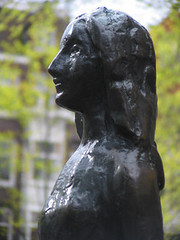
Statue of Anne Frank, Amsterdam
Originally uploaded by panopticon.
When I realized I would be traveling to Amsterdam for this university tour, one of the first thoughts that popped into my head was, "I'll be able to visit the Anne Frank House."
In fact, the opportunity to do so was one of my prime motivators in spending four vacation days there before the tour began - the tour group experienced nothing of Amsterdam but a paltry cruise through the canals.
I first read Anne Frank's diary when I was about ten years old. It immediately became a perennial for me - one of those books I experience a need to re-read every so often.
It didn't just make an impression on me, it made several different impressions on me. There was the usual one, of course, a visceral feeling of what suffering the Jews underwent during the war.
And there was another that I would venture to say has been fundamental to my view of my place in the world, and which fostered my love affair with language.
Reading the diary made me realize this:
No matter how small a person you may be, your words are just as large and loud as anyone else's, and have as much of a chance to make an impact.I read the book so many times that Anne, Margot, the Van Daans, Miep Gies and all the rest joined my mental pantheon of familiar beloved characters, most of whom (like E.F. Benson's Lucia, Sebastian Flyte, and Henry James Trotter) were fictional.
The Secret Annex, in a similar way, became a literary locale I "knew" so well I could see it with my eyes closed - like Brideshead or Lucia's house in Tilling.
This being the case, to enter the building gave me the oddest feeling of reality and unreality blending. The Secret Annex was a place I knew well from a book, but here it was, incontestably real.
A modern museum building has been put up alongside the original house. You enter through it, cross into the house, and slowly guide yourself up from the ground floor, where products made by Opekta (Anne's father's company) were packed and sent out, through the offices and storerooms on the upper floors.
The rooms themselves are mostly empty of furniture. This is a small building, and with the rooms full there'd be no space for the floods of visitors.
But the walls and floors seem remarkably well-preserved - with original wallpapers and such - so the feeling of the actual period is remarkably present.
In each room there's some kind of appropriate exhibit. In the front office, for example, Miep's typewriter and identity card sit in a glass case. On a video screen is an interview with Miep, as an old woman, talking about how after the war she was able to present Otto Frank with his daughter's diaries.
And in almost every room, there's a quote from the diary, stenciled in almost ghostly writing somewhere on the wall.
So you go through the offices and storerooms, and then...
You come to the sliding bookshelf, and it's open. And you go past it, bending to fit through the hole. You imagine Anne herself sneaking back and forth at night, fearing that neighbors would see or hear something. You hoist yourself up the step with one hand on the doorframe, your hand where her hand must have rested.
Behind that shelf, claustrophobia reigns. It's a cliché to say this, but until you've stood there, it's hard truly to conceive the cramped nature of the place.
Even empty of furniture, the rooms are close and dim. With true blackout curtains hanging, it must have been worse than a cave.
Details jump out at you. In the main room, there's the stove. It hardly looks big enough to cook meals for one person - how could it have served them all?
The floors creak. You can hear people above you walking about. You remember Anne wrote about trying to move silently so that nobody working below would hear. Now you understand. You imagine living every day knowing one ill-considered footstep could mean disaster.
You come to Anne's room. The walls are still covered with pictures she pasted up from her movie magazines. The sorts of things any kid her age would put up in her room.
There are Margot's Latin exercises, Otto Frank's copy of Dickens, Edith Frank's prayer book.
And it starts to pound in your brain: They were real. They were real. They had possessions, interests, prejudices, talents, secrets, and they were here.
You are standing in the midst of the story, walking where they walked.
(The bells of the Westerkerk went off while I was there, and you could hear them loud and clear, just as Anne did, a voice from the outside world.)
You come into the attic, where a long large room (once meant for goods storage) has the transportation cards of all the refugees from the Secret Annex displayed. Suddenly, Anne is reduced to a name, picture, and a few statistics on a card. Another Jew girl heading for a concentration camp.
There's an interview playing of one of the last people to see her alive in Bergen-Belsen. She almost made it through the war. Almost.
And then you go into the next room, the final room, and there it is. Under glass, on a pedestal.
The diary.
Kitty.
Dear God, it's so small.
The room is silent except for the sound of a few visitors crying.
So much was lost in the war, and yet this (or these, really - Anne wrote in three books) survived.
What if she hadn't begun keeping a journal?
What if she hadn't been so honest and thorough?
What if Miep hadn't found and saved the books?
What if Otto Frank had not survived to reclaim them?
What if they had never seen the light of day again?
This house would be nothing but another canal house on the Prinsengracht.
The people who hid there would be statistics. We might know their names and ages and nothing more. We might know nothing of them at all.
How many other Anne Franks were there? Who kept no diary? Who left no trace?



17 comments:
Wow, Franklin, this is one of the most intense and thought-provoking blog posts (or travel notes of any kind) that I've ever read. Thanks so much for describing this so clearly so that we could imagine ourselves there too. It sounds like an incredible experience and I'm so glad that you had the chance to see it.
I'm also glad you're home safe and I hope to see you soon! xoxo
What a powerful experience. Thank you for sharing you impressions, thoughts, emotions. I remember when I was young, reading the diaries for the first time, how badly I wanted her to survive -- even though I knew she hadn't -- and how re-reading it still fills me with the same hope, "Maybe this time she will make it!" I imagine that nothing could make me infuse the reality of her life and what happened with her diary more profoundly than seeing the Anne Frank House. Reading your post is the next best thing. And the photograph is just beautiful.
Amazing. You have a gift for making someone feel they are right there.
And I desperately need to re-read that book.
Just beautiful, Franklin. Thank you for sharing.
Thanks for writing such a wonderful and inspiring post.
Franklin,
Quick blogging question. I hope you can help. I noticed you were able to get your profile picture posted on your blog's profile section. I just cannot find the toggle, or know the html steps to get my Blogger profile picture to post under the "About Me" section.. would appreciate any advice you can point out.. Thanks. Kurt
If the Anne Frank house moves you, the Resistance Museum (Verzetsmuseum) in Amsterdam is also well worth a visit. It's a very good museum and much less busy than the Anne Frank house. Currently there's an exhibit on gay men during WWII.
I visited the secret annex in 1988. And felt very much as you did. Although we read kitty knowing it is true, being in that house, seeing those small cramped spaces -- it was like reality giving me a sucker punch.
You are such a talented writer, and most of all I liked your questions towards the end of your piece. Especially the last one. The resonance of that question; because of course, we all know there were many.
Once again, thank you for such an inspired and inspiring blog.
Charli
Charlizeen@yahoo.com
Dang, when are you going to write a book? Your words are so easy to read; I'm really impressed by the way you evoke feelings. I came on looking for a knit shop for my visit to Amsterdam, and had to read everyone of your postings. Very nice. Put down the knitting needles (very hard for a avid knitter like myself to say) and give the world a book, we'd love it.
I haven't read the book, though I did, long ago, read the play. And I know you wrote the post two years ago, but it brought tears to my eyes. Thank you for making it real.
That was some piece of writing.
I think it's going to haunt me.
I often get a little misty eyed reading some of the more "intense" posts on the various blogs I read. This is the first time that a post has had tears rolling down my face. Thank you.
"Many Theresas have been born who found for themselves no epic life wherein there was a constant unfolding of far-resonant action; perhaps only a life of mistakes, the offspring of a certain spiritual grandeur ill-matched with the meanness of opportunity; perhaps a tragic failure which found no sacred poet and sank unweptinto oblivion." -- Middlemarch
Franklin,
Your being touched by this and sharing your experience with your beautiful writing are just as important in making sure we never forget.
*tissue please.* You really choked this old lady up on this post. Powerful, Franklin.
Mengapa kutil bisa tumbuh di alat kelamin pria serta bagaimana mengobatinya, kutil tumbuh di sekitar kelamin pria bisa tumbuh pada batang penis pria, ujung penis pria, pangkal penis pria bahkan bisa tumbuh di sekitar anus pria. hal ini karena di sebabkan oleh virus yang bernama HPV (human papilloma Virus) sebelum melakukan pengobatan terlebih dahulu akan saya jelaskan mengenai virus HPV ini sehingga nanti kedepannya khsusunya untuk kaum pria dapat menjaga diri agar terhindar dari penyakit ini obat herbal manjur Kondiloma akuminatum ialah vegetasi oleh Human Papiloma Virus tipe tertentu, bertangkai, dan permukaannya berjonjot. Tipe HPV tertentu mempunyai potensi onkogenik yang tinggi, yaitu tipe 16 dan 18. tipe ini merupakan jenis virus yang paling sering dijumpai pada kanker serviks. Sedangkan tipe 6 dan 11 lebih sering dijumpai pada kondiloma akuminatum dan neoplasia intraepitelial serviks derajat ringan.
Kondiloma akuminatum ialah vegetasi oleh Human Papiloma Virus tipe tertentu, bertangkai, dan permukaannya berjonjot. Tipe HPV tertentu mempunyai potensi onkogenik yang tinggi yaitu tipe 16 dan 18. tipe ini merupakan jenis virus yang paling sering dijumpai pada kanker serviks. Sedangkan tipe 6 dan 11 lebih sering dijumpai pada kondiloma akuminatum dan neoplasia intraepitelial serviks derajat ringan. Kondiloma akuminatum ialah vegetasi oleh Human Papiloma Virus tipe tertentu, bertangkai, dan permukaannya berjonjot. Tipe HPV tertentu mempunyai potensi onkogenik yang tinggi, yaitu tipe 16 dan 18. tipe ini merupakan jenis virus yang paling sering dijumpai pada kanker serviks. Sedangkan tipe 6 dan 11 lebih sering dijumpai pada kondiloma akuminatum dan neoplasia intraepitelial serviks derajat ringan segera kontak kami untuk mendapatkan obat kutil kelamin paling manjur
Post a Comment